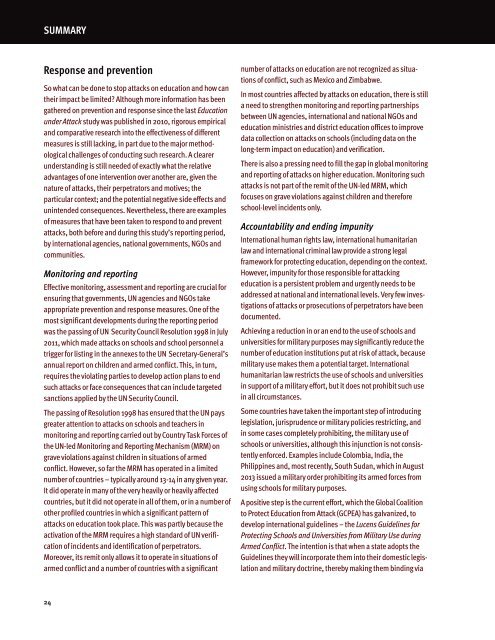You also want an ePaper? Increase the reach of your titles
YUMPU automatically turns print PDFs into web optimized ePapers that Google loves.
SUMMARYResponse and preventionSo what can be done to stop attacks on education and how cantheir impact be limited? Although more information has beengathered on prevention and response since the last Educationunder Attack study was published in 2010, rigorous empiricaland comparative research into the effectiveness of differentmeasures is still lacking, in part due to the major methodologicalchallenges of conducting such research. A clearerunderstanding is still needed of exactly what the relativeadvantages of one intervention over another are, given thenature of attacks, their perpetrators and motives; theparticular context; and the potential negative side effects andunintended consequences. Nevertheless, there are examplesof measures that have been taken to respond to and preventattacks, both before and during this study’s reporting period,by international agencies, national governments, NGOs andcommunities.Monitoring and reportingEffective monitoring, assessment and reporting are crucial forensuring that governments, UN agencies and NGOs takeappropriate prevention and response measures. One of themost significant developments during the reporting periodwas the passing of UN Security Council Resolution 1998 in July2011, which made attacks on schools and school personnel atrigger for listing in the annexes to the UN Secretary-General’sannual report on children and armed conflict. This, in turn,requires the violating parties to develop action plans to endsuch attacks or face consequences that can include targetedsanctions applied by the UN Security Council.The passing of Resolution 1998 has ensured that the UN paysgreater attention to attacks on schools and teachers inmonitoring and reporting carried out by Country Task Forces ofthe UN-led Monitoring and Reporting Mechanism (MRM) ongrave violations against children in situations of armedconflict. However, so far the MRM has operated in a limitednumber of countries – typically around 13-14 in any given year.It did operate in many of the very heavily or heavily affectedcountries, but it did not operate in all of them, or in a number ofother profiled countries in which a significant pattern ofattacks on education took place. This was partly because theactivation of the MRM requires a high standard of UN verificationof incidents and identification of perpetrators.Moreover, its remit only allows it to operate in situations ofarmed conflict and a number of countries with a significantnumber of attacks on education are not recognized as situationsof conflict, such as Mexico and Zimbabwe.In most countries affected by attacks on education, there is stilla need to strengthen monitoring and reporting partnershipsbetween UN agencies, international and national NGOs andeducation ministries and district education offices to improvedata collection on attacks on schools (including data on thelong-term impact on education) and verification.There is also a pressing need to fill the gap in global monitoringand reporting of attacks on higher education. Monitoring suchattacks is not part of the remit of the UN-led MRM, whichfocuses on grave violations against children and thereforeschool-level incidents only.Accountability and ending impunityInternational human rights law, international humanitarianlaw and international criminal law provide a strong legalframework for protecting education, depending on the context.However, impunity for those responsible for attackingeducation is a persistent problem and urgently needs to beaddressed at national and international levels. Very few investigationsof attacks or prosecutions of perpetrators have beendocumented.Achieving a reduction in or an end to the use of schools anduniversities for military purposes may significantly reduce thenumber of education institutions put at risk of attack, becausemilitary use makes them a potential target. Internationalhumanitarian law restricts the use of schools and universitiesin support of a military effort, but it does not prohibit such usein all circumstances.Some countries have taken the important step of introducinglegislation, jurisprudence or military policies restricting, andin some cases completely prohibiting, the military use ofschools or universities, although this injunction is not consistentlyenforced. Examples include Colombia, India, thePhilippines and, most recently, South Sudan, which in August2013 issued a military order prohibiting its armed forces fromusing schools for military purposes.A positive step is the current effort, which the Global Coalitionto Protect Education from Attack (GCPEA) has galvanized, todevelop international guidelines – the Lucens Guidelines forProtecting Schools and Universities from Military Use duringArmed Conflict. The intention is that when a state adopts theGuidelines they will incorporate them into their domestic legislationand military doctrine, thereby making them binding via24


